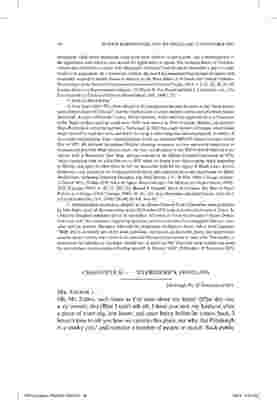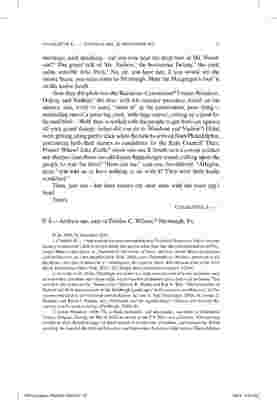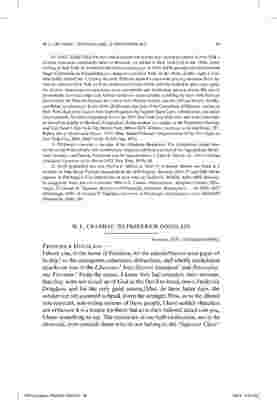Pages
1
CHARLOTTE K——1Charlotte K——- was a pseudonymous correspondent to Frederick Douglass’s Paper; her true identity is unknown. Little is known about this person other than that she corresponded from Pittsburgh. Henry Louis Gates, Jr., foreword to The Works of James McCune Smith: Black Intellectual and Abolitionist, ed. John Stauffer (New York, 2006), xxx; Christopher L. Webber, American to the Backbone: The Life of James W. C. Pennington, the Fugitive Slave Who Became One of the First Black Abolitionists (New York, 2011), 357; Ripley, Black Abolitionist Papers, 4:226n. TO FREDERICK DOUGLASS
Pittsburgh, Pa. 26 Nov[ember] 1853. MR. EDITOR :—
Oh, Mr. Editor, such times as I’ve seen about my letter! ([P]ut this into a sly corner, do.) [B]Jut I can’t tell all. I have just sent my husband after a piece of roast pig, you know; and must hurry before he comes back. I haven't time to tell you how we came to this place, nor why; but Pittsburgh is a smoky city,2As early as the 1850s, Pittsburgh was home to a high concentration of heavy industries such as ironworks, foundries, and cotton mills, which together produced a great deal of air pollution. This earned it the nickname the “Smoky City.” Edward K. Muller and Joel A. Tarr, “The Interaction of Natural and Built Environments in the Pittsburgh Landscape,” in Devastation and Renewal: An Environmental History of Pittsburgh and Its Region, ed. Joel A. Tarr (Pittsburgh, 2003), 16; Joseph L. Scarpaci and Kevin J. Patrick, eds., Pittsburgh and the Appalachians: Cultural and Natural Resources in a Postindustrial Age (Pittsburgh, 2006), 81. and contains a number of people to match. Such public
2
meetings, such speaking—did you ever hear the deep bars of Mr. Woodson?3Lewis Woodson (1806-78), a black nationalist and abolitionist, was born in Greenbriar County, Virginia. During the War of 1812, he served in the U.S. Navy as a cabin boy. After moving to Ohio in 1820, Woodson taught in black schools in Chillicothe, Columbus, and Gainesville. While teaching, he founded the African Education and Benevolent Society to help support black children who were prevented by state law from attending public schools. He also aided the Underground Railroad, and once went to Kentucky to rescue a fugitive slave who had been kidnapped in Ohio. In 1831, Woodson moved to Pittsburgh, where he taught school, worked as a barber, and earned extra income by lecturing on physiology and hygiene. In 1832 he cofounded the Pittsburgh African Educational Society with John B. Vashon. Under the pseudonym “Augustine,” he wrote to the Colored American in the 1830s, espousing moral reform and black nationalism. Having been ordained by the African Methodist Episcopal Church in 1828, Woodson ministered at a Pittsburgh A.M.E. church for nearly three decades. He organized Pittsburgh’s first black temperance society in 1834, was a trustee of Wilberforce University, and a manager of the abolitionist Union Missionary Society. He participated in the black national convention movement in the 1830s and attended the black state convention of Pennsylvania in 1841. During the 1850s, Woodson was a strong a proponent of the National Council of the Colored People. Ripley, Black Abolitionist Papers, 3:259-60. The grand talk of Mr. Vashon,4John Boyer Vashon (?—1853) operated a barbershop and bathhouse in Pittsburgh. He joined the American Anti-Slavery Society and served on its board of managers in the 1830s. Vashon attended several National Negro Conventions, including the 1853 Rochester gathering that launched the National Council of Colored Men. Douglass frequently visited Vashon’s home while touring the Midwest and eulogized him as “one of the most consistent advocates of the slave’s freedom, and of the colored man’s elevation, who has yet arisen among our proscribed race.” FDP, 20 August 1852, 15 July 1853, 6 January, 8 September 1854; Salem [Ohio] Anti-Slavery Bugle, 7 January 1854; Quarles, Black Abolitionists, 20-33, 81, 108, 200; R. J. M. Blackett, “... 'Freedom, or the Martyr’s Grave’: Black Pittsburgh’s Aid to the Fugitive Slave,” Western Pennsylvania History, 61:117-34 (April 1978). the boisterous Delany,5Martin Robinson Delany. the cool, calm, sensible John Peck.6John Peck (?-1885), agent for the Liberator, Emancipator, Weekly Advocate, and Colored American, was a self-employed barber in Carlisle, Pennsylvania, who later worked as a clothier, restaurateur, and wigmaker in Pittsburgh. After 1847, Peck is also identified as a minister. He presided at the State Convention of Colored Freemen in Pennsylvania in 1841 and attended nearly every National Negro Convention held between 1831 and 1864. The Rochester convention of 1853 named him an original delegate to the National Council. From 1849 until 1854, Peck sat on the board of trustees of the Allegheny Institute, a school designed to train black teachers and ministers. After 1857 he briefly supported emigration as a solution to the problems faced by black Americans. Peck secured a place on the executive committee of the Church Anti-Slavery Society of Pittsburgh in 1860 and became vice president of the National Equal Rights League in 1864. George H. Thurston, Directory of Pittsburgh and Allegheny Cities, . . . for 1865—‘66 (Pittsburgh, 1865), 281; New York Weekly Advocate, 7 January 1837; New York Colored American, 4 March 1837; NS, 25 August 1848; FDP, 27 January, 28 July, 1, 8 September 1854, 30 March 1855; New York Principia, 11 February 1860; Cleveland Gazette, 5 December 1885; Proceedings of the Colored National Convention, Held in Rochester, July 6th, 7th and 8th, 1853 (Rochester, 1853), 6, 46; Proceedings of the National Convention of Colored Men, Held in the City of Syracuse, N.Y., October 4, 5, 6, and 7, 1864 (Syracuse, N.Y., 1864), 29; Ullman, Martin R. Delany, 18, 31, 41-47; Quarles, Black Abolitionists, 20, 26, 33, 110, 231. No, sir, you have not; if you would see the smoke blaze, you must come to Pittsburgh. Here the Macgregor’s foot7The phrase is taken from Sir Walter Scott’s Rob Roy (1817): “Speak out, sir, and do not Maister or Campbell me—my foot is on my native heath, and my name is MacGregor!” Walter Scott, Rob Roy (London, 1966), 323. is on his native heath.
How they did pitch into the Rochester Convention!8On 6-8 July 1853, the National Convention of Colored Men met in Rochester, New York. More than one hundred delegates from several Northern states were present. Frederick Douglass was chair of the Committee on the Declaration of Sentiments, and he coauthored and read “Address of the Colored National Convention to the United States,” which stated the case for full citizenship for black Americans. FDP, 15, 22 July, 5 August 1853. I mean Woodson, Delany and Vashon;9Although Lewis Woodson and John B. Vashon attended the National Convention of Colored Men in Rochester, neither was selected for membership on the National Council of the Colored People created by that body, which may have caused them to feel slighted. FDP, 15, 22 July 1853. the first, with his massive presence, rolled up his sleeves, and, knife in hand, “went in” at the constitution, poor thing—reminding one of a great big cook, with huge carver, cutting up a poor little reed bird.—Well, they wrestled with the people to get them set against all your grand doings. (what did you do to Woodson and Vashon?) [A]nd were getting along pretty slick when the tickets arrived from Philadelphia, containing both their names as candidates for the State Council. Then, Presto! Whew! John Zuille10John J. Zuille (1814-94) was a black printer and teacher who served as a leader in New York’s African American community. Born in Bermuda, he settled in New York City in the 1830s. After moving to New York, he worked for the Colored American. In 1830, Zuille attended the first National Negro Convention in Philadelphia as a delegate from New York. In the 1840s, Zuille taught at Colored Public School No. 2. During the early 1850s he opened a successful printing business. From the time he settled in New York until the abolition of slavery, Zuille actively worked to gain equal rights for African Americans by supporting state conventions and facilitating petition drives. He served prominently in several important African American organizations, including the New York Political Association, the Phoenix Society, the United Anti-Slavery Society, and the African Society for Mutual Relief (as secretary). In the 1850s, Zuille was chairman of the Committee of Thirteen, a group of New York black civic leaders who worked against the Fugitive Slave Laws, colonization, and racial discrimination. He suffered property loss in the 1863 New York City draft riots, and in the aftermath he moved his family to Hartford, Connecticut. Zuille worked as a cashier at the Freedmen’s Savings and Trust Bank’s New York City branch from 1866 to 1874. Webber, American to the Backbone, 357; Ripley, Black Abolitionist Papers, 3:337-38nn; Daniel Perlman, “Organizations of the Free Negro in New York City, 1800-1860,” JNH, 56:188 (July 1971). never saw one J. Smith turn a corner quicker nor sharper than these two old fogies flapped right round, calling upon the people to vote for them! “How can we,” said one, bewildered, “Alleghanian,11Pittsburgh is located at the edge of the Allegheny Mountains. The Alleghenies extend from north-central Pennsylvania into southwestern Virginia and form a section of the Appalachian Mountains. Scarpaci and Patrick, Pittsburgh and the Appalachians, 1; Leon E. Seltzer, ed., The Columbia Lippincott Gazetteer of the World (1952; New York, 1970), 46. you told us to have nothing to do with it! They were both badly scratched.”
Then, you see—but here comes my dear man with the roast pig’s head.
Yours,
CHARLOTTE K——.
P. S——Address me, care of Fairfax C. Wilson,12In all probability this was Fairfax C. Milton (c. 1843—?). A barber, Milton was listed as a member of John Boyer Vashon’s household in the 1850 Census. Between 1856-57 and 1868-69 he appears in Pittsburgh’s City Directories (at least once as Fairfax C. Millin). After 1869, however, he disappears from that city’s records. 1850 U.S. Census, Pennsylvania, Allegheny County, Pittsburgh, 32; George H. Thurston, Directory of Pittsburgh, Allegheny, Birmingham . . . for 1856-1857 (Pittsburgh, 1856), 41; George H. Thurston, Directory of Pittsburgh and Allegheny cities 1868/1869 (Pittsburgh, 1868), 265.12 Pittsburgh, Pa.
PLSr: FDP, 26 November 1853.



